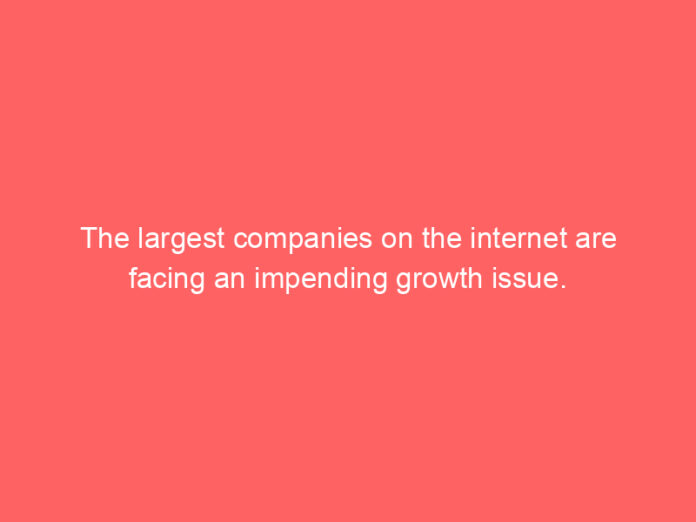
For the majority of the last 20 years, internet-based enterprises have experienced rapid growth.
The sector might be about to move into a new period of slower growth.
While e-commerce may increase at a moderate rate, digital advertising may be the most saturated.
The largest companies on the internet are moving into a new phase of slower growth after two decades of largely unrestricted expansion.
Bernstein Research, a leading tech analysis firm on Wall Street, says as much.
In a research report this week on the forecast for 2024 and beyond, Mark Shmulik and Nikhil Devnani of Bernstein said, “There is a general concern among Internet investors that core revenue pools may be approaching saturation, with growth at risk of being structurally lower going forward.”
Growth rates dropped by half.
Four of the biggest Internet industries—cloud computing, e-commerce, transportation and delivery, and digital advertising—were examined by the analysts in terms of growth rates.
These sectors are predicted to develop at a rate of around half that of 2019 in 2024.
“This debate is perhaps most evident in (though not isolated to) digital advertising, where traditional cuts of the market point to a 70%+ online penetration rate,” Shmulik and Devnani stated.
Wayfair is hardly the only one.
Market penetration in e-commerce, excluding food, auto sales, and gas, is currently around 20%. This industry is already halfway through the migration curve if it peaks at 30% to 40% of all retail.
Using Wayfair as an example, the analysts said, “It certainly feels like our eCommerce businesses are entering a transition period from new user adoption to retention and re-engagement.”
There are currently over 85 million customers of that online furniture company. This represents “a substantial percentage of the total addressable households — meaning the company now has to increasingly rely on re-acquisition to drive customer growth,” the authors said.
The analysts continued, “We don’t think Wayfair is alone.” “We should be prepared for a moderation in growth rates going forward.”
Additional indicators
They also mentioned additional indicators of a slowdown in growth.
Recent years have seen a number of new apps dominate the download rankings, indicating that users may be growing weary with the main online services they have been using for the past ten years.
Additionally, several businesses—including Meta and Alphabet—have modified their names and missions to reflect their intense pursuit of cutting-edge technologies like web3 and the metaverse.
Battles on the turf
Large tech corporations begin scouting out neighboring markets and attempting to encroach on each other’s territory when growth slows.
Amazon is entering the automotive business and competing with Google and Meta in online advertising.
In cloud computing, Amazon and Microsoft are being challenged by Google. Microsoft made an attempt to seriously compete with Google in the search market last year, but Amazon has been able to reduce Google’s market share.
With its Oculus line of consumer hardware, Meta is taking on Apple. With its Pixel smartphones, Google has been making similar advancements in mobile hardware.
Amazon is being challenged by TikTok for market share in e-commerce. With Threads, Meta is encroaching on Twitter’s turf in social media.
Generative AI is currently being chased by everybody and their brother as the next big tech platform opportunity. Not one of them can prevail.
Dollars versus percentages
Indeed, forecasts of internet market saturation and Big Tech slowdowns have been made in the past. Concerns about “Peak Google” were covered by blogger Ben Thompson in 2014. Since then, the stock has increased by over five times. Now, revenue has increased by over four times.
The fundamental markets of the internet are “still significant, with demographic and behavioral tailwinds persisting as well,” as Shmulik and Devnani stated in a piece published this week.
Furthermore, they pointed out that even while percentage growth rates are low, more funds are being brought in.
Concerns regarding AWS’s slower growth rate were addressed by Amazon CEO Andy Jassy in late October, when he emphasized absolute dollars over percentages.
“AWS experienced 12% year-over-year growth. Additionally, I believe that our growth rate from year to year stabilized. And it included $919 million in additional sales from quarter to quarter,” he stated, as per a transcript of Amazon’s earnings conference call for the third quarter. “As far as we can tell, that also looks like the most absolute growth of any of the players out there.”
It’s concerning when Big Tech CEOs begin discussing dollar growth instead of percentage growth.
It first demonstrates the application of the law of large numbers. Given its current size, AWS finds it more difficult to expand its revenue at the rate of thirty to forty percent per year, as it did only a few years ago.
However, investors are also concerned because Amazon is currently valued at more than $1.5 trillion on the market. Expectations of robust future growth, expressed in percentage terms rather than just dollars, contribute to this enormous valuation.














































